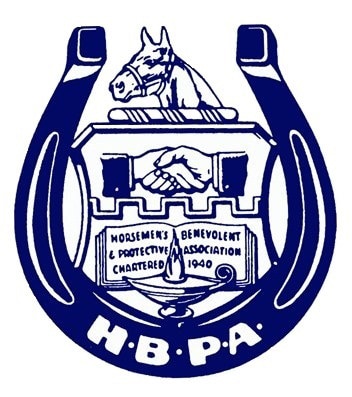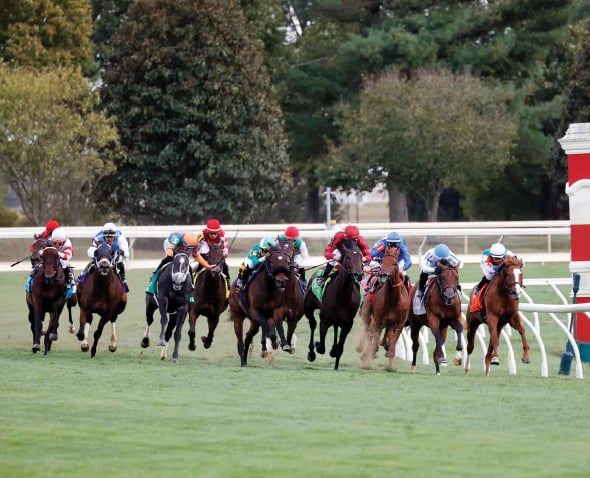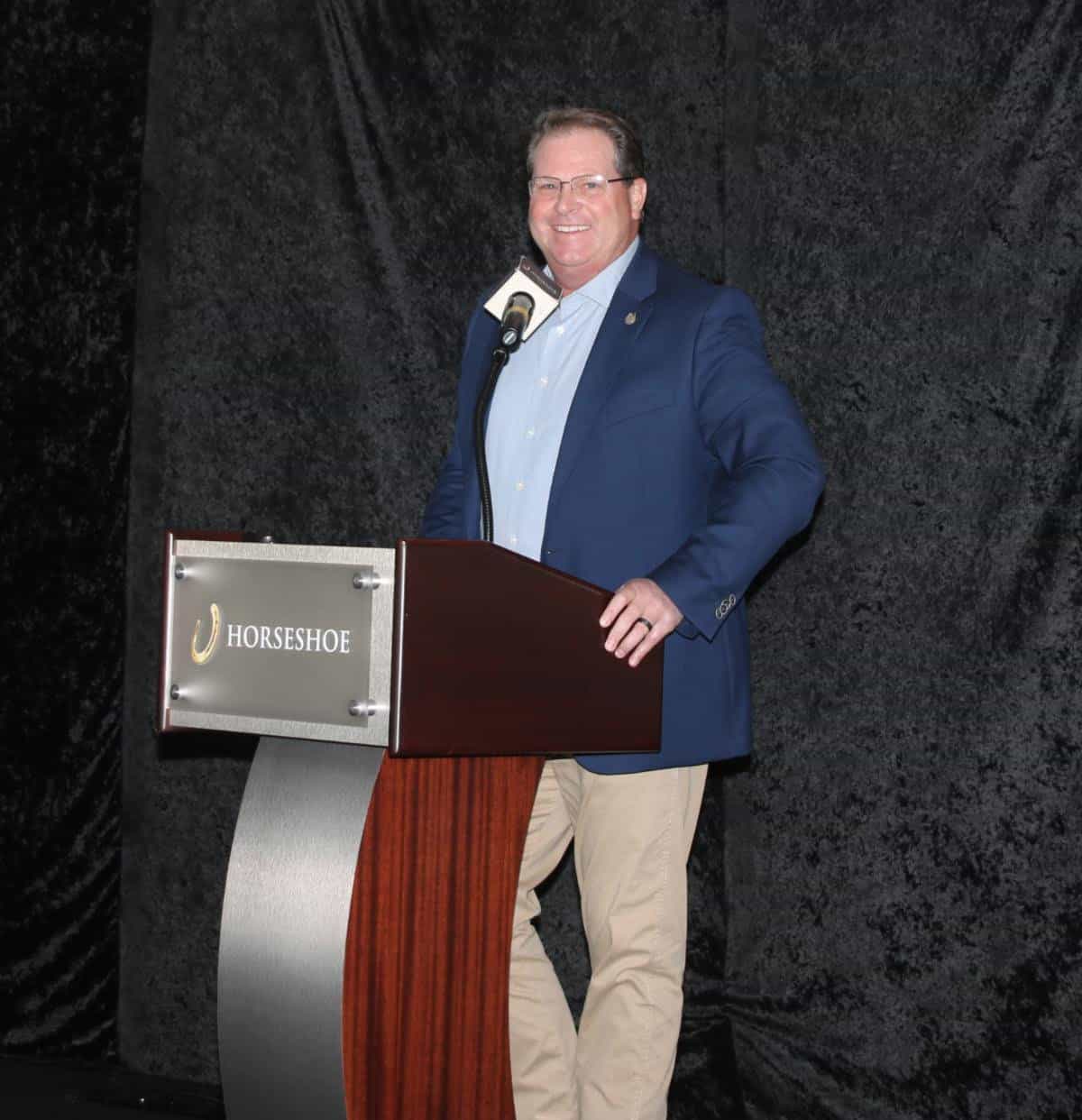Horsemen should start preparing for sports betting now, panel tells National HBPA Convention

Keynote speaker Clay Whitham (Photo by Denis Blake)
Happening at warp speed: Horsemen should start preparing for sports betting now, panel tells National HBPA Convention
‘It’s vastly more complicated and risky than parimutuel horse racing… If you’re not well-advised, you could be left behind.’
To appreciate how public opinion on sports betting has changed in recent years, consider that the National Football League went from banning Las Vegas commercials on the Super Bowl broadcast to relocating a team there.
While the NFL still opposes sports betting, the National Basketball Association and Major League Baseball now favor legalizing wagering on sporting events and are lobbying various states to receive a piece of the revenue. Speaking at the Wednesday panel on sports betting that kicked off the National HBPA convention, moderator Michele Fischer said the American Gaming Association estimates that $150 billion is bet on sports by Americans each year, most of that through offshore bookmakers.
The panelists’ message was that horsemen and racetracks should be acting now to prepare for the advent of sports betting in America. But just because racetracks understand parimutuel wagering, taking bets at fixed odds on sports requires completely different expertise.
The annual convention of the National Horsemen’s Benevolent and Protective Association features three days of sessions on issues and developments facing horse racing, wrapping up Saturday morning with a meeting of the National HBPA board at the Astor Crowne Plaza Hotel in the famed French Quarter.
The United States Supreme Court is expected to rule this spring on New Jersey’s challenge to the constitutionality of the Professional and Amateur Sports Protection Act (PASPA), which for the last quarter-century effectively has made sports betting illegal except in Nevada and a few other stakes.
“In 2012, the idea of sports wagering throughout the United States was just a long shot,” said Fischer, who is vice president of sales and business development for Sportech Racing and Digital. “The sports leagues sued the state of New Jersey to block sports wagering in Atlantic City casinos and the state’s racetracks. They called it a clear violation of the federal ban on state-sponsored sports betting and threatened their integrity…. Now we wait for the United States Supreme Court to potentially strike down the 25-year-old statute. During the six-year battle the momentum has changed. We’ve got 18 states and three governors now supporting the New Jersey case… There are close to two dozen states considering bills to legalize sports betting.”
Joe Asher, chief executive officer of William Hill US, urged racing to follow the lead of Monmouth Park in pushing to legalize betting on sports. Monmouth is leased by the horsemen, who have partnered with William Hill on the sports-betting initiative.
“Until Congress gets involved, it’s going to be a state issue,” Asher said. “And among the most critical decisions at the state level is who gets the license, who gets the right to offer the product. Certainly under the old legislation in New Jersey and one would think under the new legislation, the racetracks will get that right. That may not be the case in all states. Clearly, in my mind, the No. 1 thing is to be involved in the legislative process in trying to get some form of either getting the licenses or some entree into it.”
Alex Waldrop, president of the National Thoroughbred Racing Association, offered another top priority.
“The No. 1 thing you should do is be on the phone with a William Hill or somebody else who does know this business. Because this is not our business,” Waldrop said. “It’s vastly more complicated and risky than parimutuel horse racing. You should not go down this road thinking this is just another case where you’re going to divvy up purse money. If you’re not well-advised, you could be left behind.”
Industry consultant Dr. Jennifer Durenberger said that while the push for sports betting has similarities to racetracks’ pursuit of expanded gaming, “it’s happening at warp speed.
“… If the agency that regulates horse racing in your state will have oversight, or potentially merging with one that will, your existing, long-standing relationships with your regulatory body and your legislature are going to be key here. Relationships are critical.
“… I caution you to not make this an us vs. them game, which I think in horse racing we have a history of doing. I think the potential benefits to horse racing are going to be via a cooperative effort…. Two things that are going to be critical going forward that sports betting shares with horse racing is betting integrity monitoring and anti-doping. Those are things we have a long-standing tradition of regulating on a state by state basis and we have a lot to offer in our experience with that.”
Durenberger said horse racing brings something else to the table that resonates with lawmakers.
“You are thousands of small-business owners, and you have the privilege and the blessing to work in an industry that has economic impact for your states in very large numbers,” she said. “In my state of New York, it’s over $4 billion — with a ‘b.’ Even in small states, it’s tens of millions of dollars. Your small businesses sustain green space. You have all of the tax base, all the ancillary things that go into the agribusiness. That economic-impact argument is still very, very relevant. …. Your industry supports the rural economy, as opposed to a handful of franchise owners and leagues.”
Whithams’ patience with Bayakoa’s offspring pays off
The convention’s keynote speaker was Clay Whitham, who runs Whitham Thoroughbreds with his mother, Janis. Whitham Thoroughbreds and its broodmare band of about 10 mares stands as a testament to patience. Their great Hall of Famer Bayakoa only had four foals — only two of which raced, only one winning a single race.
“Maybe there’s something about leaving it all on the racetrack,” Whitham said. “She was a great race mare but as a broodmare she wasn’t successful as a dam. But out of the two fillies that she had that we kept, they have both produced Grade 1 stakes winners.”
One of those was Fort Larned, the 2012 Breeders’ Cup Classic winner out of the Broad Brush mare Arlucea. Trinity Place, Bayakoa’s other daughter in the Whitham broodmare band, was sired by Strawberry Road and produced multiple Grade 1 winner Affluent.
“Broad Brush and Strawberry Road both had a lot of starts and were really good racehorses,” Whitham said. “They weren’t the most fashionable commercial sires, but they were good tough racehorses. We try to remember that. It’s easy to get excited about the latest 2-year-old champion that got retired and forget about the good, tough racehorses. But I think that’s important.”
Horsemen as citizen marketers: Share racing’s unique experiences
A Wednesday panel titled Horsemen as Citizen Marketers: Be Part of the Solution encouraged owners and trainers to embrace racing’s inordinate public access, giving fans unique experiences and using social media to promote to their stables and the sport.
“If you’re following this sport, you’re passionate about it,” said Greg Bensel, whose hats include being the senior vice president of communications/broadcasting for the New Orleans Saints and New Orleans Pelicans, as well as overseeing the horse-racing and breeding operations of Saints owner Tom Benson and his wife, Gayle. “You care about it. It is a great, great sport. We look all the time, why and how is the NFL so popular?… Why isn’t horse racing getting the traction it should? Because it is a phenomenal sport.”
Bensel organized a fundraiser for New Orleans’ Isidore Newman School where 250 alumni paid $100 each to attend night racing at the Fair Grounds. “Of the 250, 235 had never been to the racetrack,” he said. “By the time the night ended, everyone came up to me and said ‘This was the best night.’ We had handicappers walking around teaching people.
“What you guys do is so unique,” he said. “It’s unlike any other industry, any other sport. It’s selling that behind-the-scenes access. One thing I’ve found out about horse racing is that all doors are open. You go to the NFL and you’re restricted to getting on the field pregame for 30 minutes in a sequestered little corner. The other night, when I had my Newman folks, I took them everywhere, and everyone was kind and open. And without getting anyone kicked in the head by a horse, we brought it right up close. And that’s important. We need to get that on the air, get that on everyone’s timelines on Facebook and Twitter.”
Equine attorney Peter Sacopulos provided the statistics that 69 percent of Americans use some type of social media, including 68 percent on Facebook. In Europe, 73 percent use some type of social media, he said. For the dos and don’ts of social media, read Part 1 of Peter Sacopulos’ The Thoroughbred Trainer in the Digital Age that appeared in Trainer Magazine.
Michael Beychok, a political consultant from Baton Rouge who also is a prominent horseplayer and a horse owner, added that the number of people between the ages of 18 and 35 using social media “is near 90 percent.
“That is the core of the people we need to reach if we’re going to try to grow this game,” said Beychok, the only person ever to win $1 million in tournament play when he captured the 2012 National Handicapping Championship. “We can promote it to ourselves, and it really doesn’t make any difference. But the group we’re trying to reach, and the way they get their news and information is on social media. They don’t watch TV anymore. I know this from doing campaigns where we are trying to target these voters. You cannot find them on television. They’re watching Netflicks or Hulu. You can’t advertise on those channels.
“You have to find channels — not necessarily TV channels, but the people. Drew Brees is a channel. He distributes information through his social media. The Saints are a channel. As you find people who have better channels than you do, it’s an opportunity to use, especially to the people that we are trying to grow this game and promote this game.
“… Those of us who love the game, horseplayers, trainers, breeders, owners, we’re really forced to promote ourselves. Social media is a terrific opportunity to do that as a collective group…. Everybody can do it. As a collective group, you can reach hundreds of thousands of people.”
Doug Tatum, the Saints and Pelicans’ executive director of digital media, attended the session and was asked how to reach that younger audience that doesn’t have horse racing on their radar.
“I don’t know if there is a particular hashtag you use,” said Tatum, the former sports editor of New Orleans’ Times-Picayune and lifelong horse-racing fan. “I think the idea of influencer marketing is really very smart. If I was a California racetrack owner, I’d figure out a way to get one of the Kardashians there one day.
“… If I was a trainer, if I ran a stable, it’s your story. You should own it. You should care deeply about how you’re being perceived publicly…. Now you can tell that story and you should be telling that story yourself. That’s what Greg and I do with the Saints and the Pelicans — it’s our story to tell, not some newspaper story to tell. The core principles are: Tell people what they don’t know, take them where they can’t go, and if possible move them emotionally. Make them laugh, make them cry. Make them feel nostalgic. If you do that, the quality of your content is just going to get people in. The most valuable thing is a share on Facebook or a retweet on Twitter.”
Tom LaMarra, managing editor for the Thoroughbred Horsemen’s Association’s THARacing.com website, said he was hired in part because the THA had no website at the time.
“What the website really is, is kind of horsemen’s news and resources website,” he said. “But a big part of the reason for it is to get stuff out there that is no longer covered by what is left of the racing press…. The purpose of the website was to get stuff out that progress is being made. If people don’t want to acknowledge it, that’s fine. But the horsemen need to have something out there that shows what’s going on… A lot of it is dry content…. We send out stuff that is mainly of interest to horsemen. If a threshold (testing) level changes on a drug, where there’s been eight positives in one state — which is a sign that there’s probably a problem — that goes on (the website) so people understand what’s going on.”
LaMarra acknowledged not being comfortable with thinking of what he does as marketing, preferring terms such as outreach and advocacy. But he said that promoting everything racing is doing to take care of retired racehorses, including finding them second careers, today is an important component of selling the sport.
“What it does is send a positive message out to the public that people care about their horses,” he said. “That might not be (traditional) marketing but it’s probably one of the biggest forms of marketing you can do.”
Also Wednesday
Among Wednesday’s presentations: J. Curtis Linnell, executive vice president of the Thoroughbred Racing Protective Bureau, told the audience that the TRPB digital tattoo should replace lip tattoos starting in 2020. The horse identifier will scan horses’ microchips to bring up their digital tattoos.
Susan Martin, who directs the sales and marketing efforts for The Jockey Club Information Systems Inc., provided an update on new products available for horsemen. Patrick Thompson, executive director of the National Racing Compact, gave an overview of the National Racing Compact, a service that enables racing participants to obtain licensure in multiple states by being a member of the NRC. Dr. Kelly Vineyard, a senior nutritionist for Purina Animal Nutrition’s Equine Technical Solutions, offered strategies for nutrition and gastric support for racehorses.





